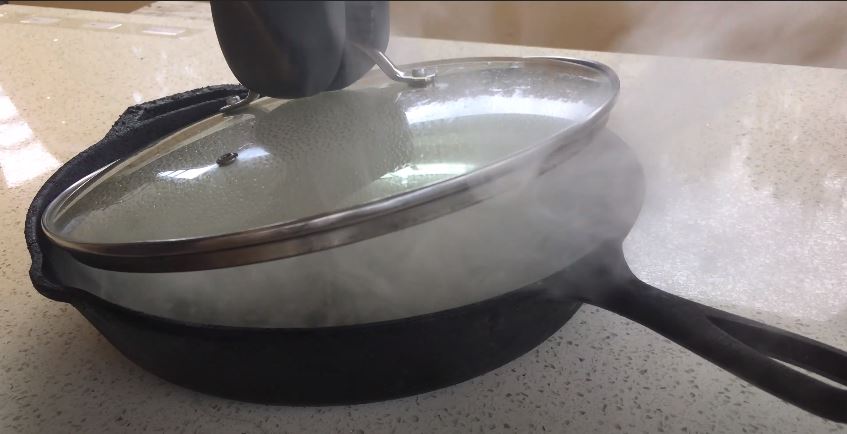Where’s that damn kitchen towel? Do I even own a trivet? Can I just put it on the countertop? Do any of the above sound familiar?
If you’re anything like me, those questions are the constant litany that accompanies cooking in my kitchen.
Every time I pull a pan or tray out of the oven I spend a minute or two dancing around trying to decide where to place it. Eventually, it gets dumped on the unit when my hand starts to burn!
The problem is, I’m never sure whether I’m going to ruin my granite worktop by putting my tray of cookies on top of it.
Is a tray of vanilla cookies worth irreparable damage to the counters? I mean that really depends on how hungry I am but financially, probably not.
So, let’s figure this out together.
What’s the Deal With Granite Countertops?
Granite countertops are like the holy grail of kitchen worktops. Everyone who’s anyone has granite countertops. But why?
Well, the first thing to love about granite worktops is that they are 100% natural. Kitchen designers vouch for the timeless beauty and elegance of granite.
Granite slabs are blasted from quarries in places like Brazil, Italy, and China. These hunks of stone are then cut into neater slab shapes by milling machines.
Before they reach your kitchen, granite slabs are rough and raw. The milling process not only cuts the slabs down to size, but it also polishes the granite to give it that smooth, shiny look.
Once cut down to around 9 feet, the slabs are shipped to showrooms. These are what you’ll view when you’re looking for new kitchen worktops.
After you’ve selected your granite based on the color and pattern, that slab is fabricated to match the dimensions and layout of your kitchen. The edges are trimmed and finished last ready for installation.
Because granite is a natural product, no two slabs will be the same in terms of color and pattern. This makes it nearly impossible to match or replace a part of your countertop. Hence why we’re concerned about keeping it in tip-top condition.
As a naturally porous stone, granite requires sealing. This will be done during installation but it will need to be topped up for the life of the countertop.
Also, granite can be prone to cracking. This is because it’s a stone that’s literally blasted out of the ground.
Sometimes, rocks have faults in the center that can develop into surface cracks over time. Unfortunately, you won’t know until it happens.
Really and truly, granite countertops are a status symbol. Sure they are more hardwearing and less prone to staining than laminate, wood, or tile countertops, but they are not invincible.
Because granite is quarried abroad and needs to be shipped over here, granite is an expensive choice for kitchen countertops.
Of course, this is part of the reason why granite has become a status choice.
On average, you can expect to pay between $80-$176 per square foot. The price can change quite quickly depending on the cost of fuel as they need to be imported.
If you’re environmentally conscious then granite posses a bit of a conundrum. On the one hand, it is a natural product that doesn’t require the production of plastic-based materials.
However, on the other hand, it is quarried from the ground which can cause a fair amount of carbon emissions, habitat destruction, and waterway pollution. Then there’s the fact that granite is a finite resource.
Granite and Heat
Seeing as granite is a natural stone, you might assume that it’s fine to place a hot pan onto it.
Well, you’d be wrong. Remember that granite needs to be sealed because it’s porous. The sealer used on granite countertops is made primarily of resin.
Resin doesn’t melt when heat is applied, so you don’t need to worry about goopy surfaces. No, resin breaks down when heat is applied.
If the resin breaks down, the sealant no longer does its job. This means your expensive granite worktops are now vulnerable to staining and water damage. That’s a big no-no!
While granite is known for its durability and resistance to high temperatures, it is not entirely heat-resistant, potentially causing thermal shock and resulting in cracks or fissures. Depending on their severity and location, water seeping into the countertop can lead to further damage, especially in freezing temperatures, as the water expands when it freezes, widening existing cracks.
Small, superficial fissures may not significantly affect the countertop's structural integrity. However, larger cracks, especially those extending through the entire stone's thickness, can weaken it over time. Additionally, cracks and fissures can trap food particles and bacteria, compromising hygiene in food preparation areas.
For minor cracks, using a granite sealer can reduce water intrusion and make the cracks less noticeable. However, this won't fully restore the countertop's original condition, and the crack's appearance may still be visible.
Consult a professional stone countertop repair specialist for more substantial cracks or structural issues. They can use epoxy resin or other specialized techniques to restore the countertop's appearance and structural integrity.
How to Protect Granite Countertops
The best way to protect your worktops is to not put hot pans directly on the granite.
If you need to place a pan down for a moment while you fish out a trivet or towel, you’ll probably be ok.
Try not to do this all the time. You definitely don’t want to leave the pan directly on the countertop for more than a few seconds.
What you need is a trivet. A trivet is a bit like a placemat. Its job is to sit between the countertop and the work surface to prevent heat from damaging the countertop.
Trivets come in lots of different shapes, sizes, and materials. You can get very large ones that sit beside your oven or stovetop. These can be fixed or moveable and they act as a heatproof surface for all your pans.
If you’re short on counter space, you’ll probably want to get a trivet that is just big enough for a pan.
Trivets are most commonly made of wood or metal. Metal trivets tend to have little feet that stop the heat from transferring through the metal and into your counter.
Wooden trivets don’t really need feet. They look a bit like chopping boards though they are often slatted to allow the pan to cool down.
If you don’t have a trivet, you could use a kitchen towel. The issue is that most aren’t thick enough to prevent the heat transfer.
If you are using a kitchen towel, you’ll definitely want to fold it over a few times.
Apply a granite sealer every few weeks or months, as recommended by the manufacturer, to maintain a protective layer. Inspect for grout issues if applicable, and address as needed. Consider professional assessment annually to check for structural concerns, perform deep cleaning, and reapply sealer when water no longer beads on the surface.
Final Thoughts
Hot pans are no good for granite countertops. In the best-case scenario, the heat will break down the sealant and you’ll have to reseal.
In the worst-case scenario, the pan will cause staining or damage to the granite itself after breaking down the sealant.
If you’ve gone to the trouble and expense of having granite worktops fitted, the least you can do is protect them.
Buy yourself a trivet. They’re cheap and cheerful and they’ll save you a lot of costly repairs.






